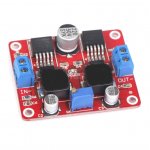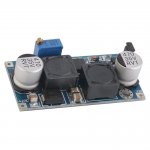Thank you nec3 for this invaluable tip! The problem is that SMPS above this ie: 30v rating is quite expensive almost impossible to source in this small foot print! Are there any other workabouts around this? say using a "buck booster"?
Would using 7815/7915 instead solve this?
This psu is only for a headphone pre amp, therefore I can perhaps run it on reduced voltages of +/- 10v I suppose with less dynamic range? I could even use a TLE2426 rail splitter instead as originally planned?
Thanks
Would using 7815/7915 instead solve this?
This psu is only for a headphone pre amp, therefore I can perhaps run it on reduced voltages of +/- 10v I suppose with less dynamic range? I could even use a TLE2426 rail splitter instead as originally planned?
Thanks
Last edited:
Thank you nec3 for this invaluable tip! The problem is that SMPS above this ie: 30v rating is quite expensive almost impossible to source in this small foot print! Are there any other workabouts around this? say using a "buck booster"?
Would using 7815/7915 instead solve this?
Thanks
As i know, most SMPS sold in the market have an variable resistors to adjust the output voltage a few volts higher/lower than the nominal.
Using A buck booster to increase 24v would increase the total cost more than a new 28v SMPS. So, not cost effective.
"Would using 7815/7915 instead solve this?"
I did not understand what you mean here.
---What is your need for output currents ?
This psu is only for a headphone pre amp, therefore I can perhaps run it on reduced voltages of +/- 10v I suppose with less dynamic range? I could even use a TLE2426 rail splitter instead as originally planned?
If 10v is ok, then worth to try, even better 9v giving another one volt for safety gap.
If your current need is around 20mA (per its datasheet), TLE2426 would do all. No need for linear regulators.
Also consider AndrewT's suggestion above.
...using 7815/7915 instead of the 7812/7912 just a stupid thought on my part!
Yes, I agree to both your suggestions. It has to drive a single NE5532 or an OPA2132, which requires 15 & 5mA? respectively both in a headphone & a phono preamp. I've not decided which chip to use...but more inclined towards the OPA '32. However, I am not sure which one of these would be the most suitable in a phono pre amp?
Ideally, I'd like the full +/-15v supply for the phono pre, so I could go all linear with a 100mA/15-0-15 v transformer which I think I have somewhere!
Yes, I agree to both your suggestions. It has to drive a single NE5532 or an OPA2132, which requires 15 & 5mA? respectively both in a headphone & a phono preamp. I've not decided which chip to use...but more inclined towards the OPA '32. However, I am not sure which one of these would be the most suitable in a phono pre amp?
Ideally, I'd like the full +/-15v supply for the phono pre, so I could go all linear with a 100mA/15-0-15 v transformer which I think I have somewhere!
...using 7815/7915 instead of the 7812/7912 just a stupid thought on my part!
Yes, I agree to both your suggestions. It has to drive a single NE5532 or an OPA2132, which requires 15 & 5mA? respectively both in a headphone & a phono preamp. I've not decided which chip to use...but more inclined towards the OPA '32. However, I am not sure which one of these would be the most suitable in a phono pre amp?
Ideally, I'd like the full +/-15v supply for the phono pre, so I could go all linear with a 100mA/15-0-15 v transformer which I think I have somewhere!
A power supply consisting of "a 100mA/15-0-15 v transformer", a bridge rectifier, a 7815/7915 and four electrolitic caps would be best (to me). No SMPS, no switching noise, no buck convertor, no rail splitter...
NE5532 is more common in audio circuits.
A power supply consisting of "a 100mA/15-0-15 v transformer", a bridge rectifier, a 7815/7915 and four electrolitic caps would be best (to me). No SMPS, no switching noise, no buck convertor, no rail splitter...
Aaaaaaargh!!!!!!!
The 7815/7915 are really inferior compared to the LM317/LM337 set for 15V, and the latter inferior compared to the Linear Tech LT1963A/LT3015.
Here's part of the problem -- the error amp circuitry in these (7815/LM317 etc) regulators is too slow and imparts its harmonics (THD) onto the supply rails -- so peakish material slogs.
The new switching regulators are designed for cell-phones and have remarkably low switching noise.
A power supply consisting of "a 100mA/15-0-15 v transformer", a bridge rectifier, a 7815/7915 and four electrolitic caps would be best (to me). No SMPS, no switching noise, no buck convertor, no rail splitter...
I couldn't agree more!
Is there any info regarding what switchers and LDOs used in that power supply?
Is there any info regarding what switchers and LDOs used in that power supply?
Which psu are you referring to?
Careful with that. What Hypex calls an SMPS lacks line regulation and hence isn't really an SMPS in the usual sense.
Then "usual sense" is false. SMPS in official sense can be regulated or unregulated it doesn't matter at all. Strictly a traditional transformer+diode+filter also operates is switch mode (since diode has only 2 conduction states: blocking and conducting). That Hypex PSU is an SMPS undoubtfully.
If you search back through Bruno's early posts here there are some hints as to the though processes behind this but it's not at all clear why Hypex uses a voltage divider (or equivalent) in the feedback loop to set the output voltage rather than a voltage reference.
The reason is: almost surely it is a fixed frequency, resonant, zero power switching converter, hence there is no way controlling transfer ratio without sacrificing more important parameters like low EMI noise and low power loss. Why do you think there is feedback at all?
Such converters can be controlled a little by changing frequency, but to maintan significant controllability high reactant power must be circulating inside, so choosing not to control at all is a reasonable decision in case of an SMPS designed for audio power amplifiers.
Which psu are you referring to?
Its the one given in the link: https://linearaudio.nl/silentswitcher
Aaaaaaargh!!!!!!!
The 7815/7915 are really inferior compared to the LM317/LM337 set for 15V, and the latter inferior compared to the Linear Tech LT1963A/LT3015.
Here's part of the problem -- the error amp circuitry in these (7815/LM317 etc) regulators is too slow and imparts its harmonics (THD) onto the supply rails -- so peakish material slogs.
The new switching regulators are designed for cell-phones and have remarkably low switching noise.
You may be right about the new IC's.. I did not compare them.
However, the worst linear power supply when designed carefully is still better than any switching supplies considering the cost, time needed for design, mtbf, working life and noise.
Is there any info regarding what switchers and LDOs used in that power supply?
My guess is LT3471 for the dual switching regulator. The article mentions the TPS7A47 LDO, so probably a TPS7A33 for the negative rail.
No idea about the buck-boost IC.
I just switched on the TLE2426 v.earth psu circuit using 2 x 9v batteries in series and it works, albeit + 9.26 & - 9.34 volts respectively. I Then replaced it with a 1A/24v SMPS psu and the TLE just got fried! The SMPS is isolated as far as I can tell (I can 't detect any connections between the input and output) I wonder if this is due to the TLE is sourcing/sinking more current ie:> 20mA or the SMPS is frying it on power up?
The h.phone pre section wasn't connected when I did this, hence no additional current was being drawn apart from an indicator LED through a 10K resistor!
Any ideas as to why this happened?
The h.phone pre section wasn't connected when I did this, hence no additional current was being drawn apart from an indicator LED through a 10K resistor!
Any ideas as to why this happened?
However, the worst linear power supply when designed carefully is still better than any switching supplies considering the cost, time needed for design, mtbf, working life and noise.
That's simply not correct.
I just switched on the TLE2426 v.earth psu circuit using 2 x 9v batteries in series and it works, albeit + 9.26 & - 9.34 volts respectively. I Then replaced it with ..............
Solved! dc socket common terminal was shorted to earth! soldered it to the = rail and it works! + 12.28v = 12.34v
Maybe this is useful:
https://linearaudio.nl/silentswitcher
I expect to have a bunch manufactured shortly.
Jan
https://linearaudio.nl/silentswitcher
I expect to have a bunch manufactured shortly.
Jan
- Status
- This old topic is closed. If you want to reopen this topic, contact a moderator using the "Report Post" button.
- Home
- Amplifiers
- Power Supplies
- SMPS for small signal analog circuits

